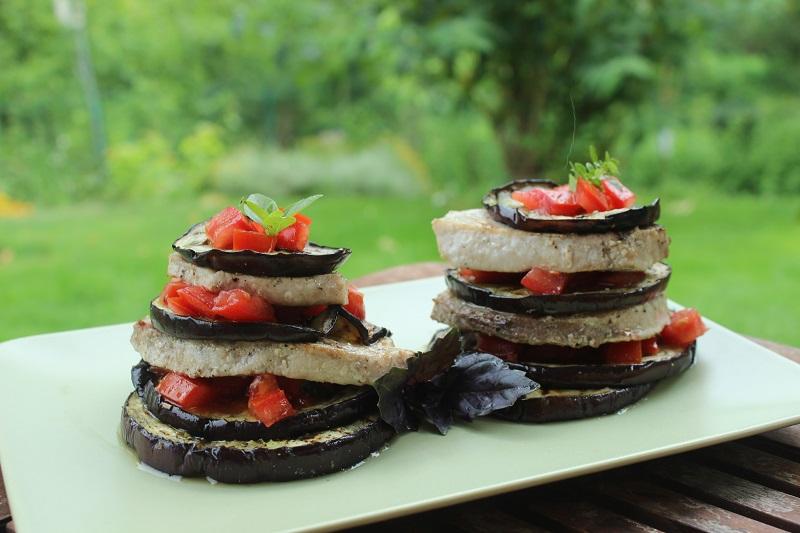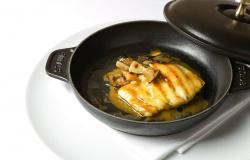Grilled Eggplant & Swordfish Towers

Unknown to—or at least uneaten by—ancient Greeks and Romans, eggplant was introduced to this part of the Mediterranean world by the Arabs during their rule of Sicily, in the 10th or 11th century. The Italian name, melanzana, is often misinterpreted in popular speech as ‘unhealthy fruit’—from mela (apple, or fruit) and insana (unhealthy; also unbalanced, insane)—due to the indigestible if not outright harmful qualities of this and other members of the Solanaceae/nightshade family when consumed raw. In truth, however, the name of this so-called ‘bad apple’ derives from a hybrid: the Arab word for eggplant, badingian, plus the later-added prefix mela. The French word aubergine, widely used in British English, comes from the Arab word al-badingian via the Catalan word albergínia. Americans say ‘eggplant’ because early European varieties were actually white, not purple. Some types did rather resemble an egg!
Long associated with lust, melancholy, and madness, the maligned eggplant did not definitively outgrow its reputation until the 19th century. Some credit Alexandre Dumas with the popularization of eggplant in European cooking; his Grand Dictionnaire de Cuisine (1873) contains recipes such as aubergine à la provençale, à la languedocienne, and à la parisienne. Not long after, in 1891 Artusi would include a selection of eggplant recipes in his famous cookbook, calling the vegetable petonciano, an early synonym of melanzana—and a word still commonly used in Florentine dialect, no doubt thanks to Artusi’s influence.
Several masterpieces of world cuisine are much indebted to the once-vilified eggplant: eggplant parmesan, caponata, moussaka, baba ghanoush, imam bayildi, ratatouille, and caviar d’aubergine, to name but a few superstars. Here’s another recipe to add to your repertoire. Enjoy!
Chop the tomato into small pieces to obtain a salsa-like mixture. Salt lightly and add about a tablespoon of chopped fresh basil and a drizzle of olive oil. Blend well and set aside.
Now make the sauce. Rinse and chop the capers and add them to the mayo or cream. Squeeze in the juice of half a lemon and blend. Store in the fridge until serving time.
Peeling the eggplant is optional. You could also partially peel them in a lengthwise ‘striped’ pattern. Slice the eggplant into ½ inch thick rounds and place the rounds in a shallow baking dish or on a large platter. Drizzle generously with olive oil and dust with salt, pepper, and the dried herbs. Let them marinate while you prep the fish. Trim the swordfish steaks into rounds roughly the same size as the eggplant rounds. Brush the fish on both sides with olive oil and lightly pepper. Grill the eggplant and the fish, and salt to taste when cooked. Assemble the towers with alternating slices of eggplant and swordfish, with scoops of the tomato salsa and more fresh basil layered in between. Serve with the caper-cream sauce.






